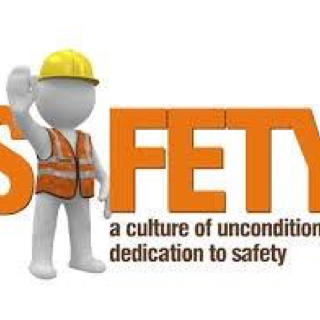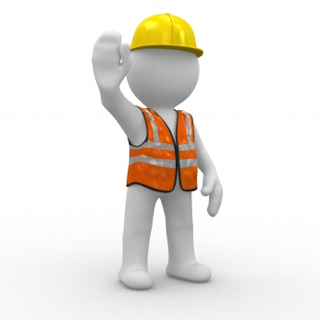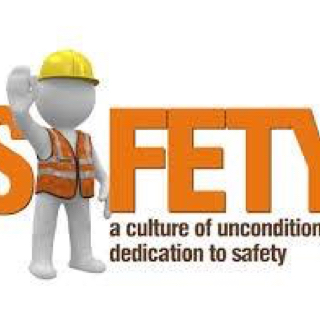Information
-
Site conducted
-
GSP Audit Document No.
Plant Information
-
Plant Location
-
Plant Manager
-
Inspection Date
-
Name of Person Conducting Audit
-
Auditor Signature
-
Internal Close Out Meeting
-
Meeting Date
-
Plant Manager
7.01 - Employer Posting & Record Keeping
-
Are the required OSHA or other applicable workplace posters displayed in a prominent location where all employees are likely to see them?
-
Are emergency telephone numbers posted where they can be readily found in case of emergency?<br>
-
Where employees may be exposed to any toxic substances or harmful physical agents, has appropriate information concerning employee access to medical and exposure records been posted or otherwise made readily available to affected employees?
-
Is the Summary of Occupational Illnesses and Injuries posted appropriately.<br>
-
Are signs concerning room capacities, floor loading, biohazards, or other harmful radiation or substances posted where appropriate?<br>
-
Are all occupational injuries or illnesses, except minor injuries requiring only first aid, being recorded as required on the required forms?<br>
-
Are employee medical records and records of employee exposure to hazardous substance or harmful physical agents up-to-date and in compliance with current OSHA standards?<br>
-
Are employee training records kept and accessible for review by employees, when required by OSHA standard?<br>
-
Have arrangements been made to maintain required records for the legal period of time for each specific type record?<br>
7.02 - Safety & Health Program
-
Is there a documented, preventative maintenance program in place?
-
Are department managers and supervisors accountable for specific safety and health activities?<br>
-
Are the general manager and department managers actively involved in the safety and health program?<br>
-
Are site inspections (audits) conducted on a regular basis?<br>
-
Is documentation of safety inspections and corrections maintained?<br>
-
Is there a system for communicating safety and health concerns to/from employees?<br>
-
Is there a safety committee?<br>
-
Are safety committee meeting records maintained?<br>
-
Are procedures/policies in place to identify and correct unsafe acts; reinforce safe operating procedures; report mechanical defects and for employees to report hazardous conditions?<br>
-
Are safety committee members, key employees, and upper management provided training in safety and health subjects?<br>
-
Is there a written accident investigation program including reporting procedures for accidents, illnesses and near misses?<br>
-
Are all accidents investigated?<br>
-
Is there a training program for accident investigators?<br>
-
Are there written training materials for accident investigation training?<br>
-
Are all incidents (near-misses) investigated?<br>
-
Are employees disciplined for unsafe safety or health acts?<br>
-
Is there an ongoing safety training program?<br>
-
Is training provided in both general and specific work practices?<br>
-
Is there a written site-specific safety and health policy?<br>
-
Are there site specific safety policies and procedures?<br>
-
Are the site-specific policies and procedures updated as appropriate?<br>
-
Is there a current certified Personal Protective Equipment Hazard Assessment?<br>
-
Is there a person who is responsible and has authority for overall activities of the safety program?<br>
-
Is there a documented hazard analysis or risk assessment program?
-
Are daily safety checklists completed?<br>
-
Are safety and health roles and responsibilities defined (i.e. department heads, supervisors, safety committee and employees?)
-
Is there a return to work program?
7.03 - Gen Work Environment
-
Are all worksites clean, sanitary, and orderly?
-
Are work surfaces kept dry or appropriate means taken to assure the surfaces are slip resistant?
-
Are all spilled hazardous materials or liquids, including blood and other potentially infectious materials, cleaned up immediately and according to proper procedures?
-
Are accumulations of combustible dust routinely removed from elevated surfaces including the overhead structure of buildings, etc.?
-
Is combustible dust cleaned up with a vacuum system to prevent the dust going into suspension?
-
Is metallic or conductive dust prevented from entering or accumulating on or around electrical enclosures or equipment?
-
Are covered metal waste cans used for oily and paint soaked waste?
-
Are all oil and gas fired devices equipped with flame failure controls that will prevent flow of fuel if pilots or main burners are not working?
-
Are work areas adequately illuminated?<br>
-
Are all toilets and washing facilities clean and sanitary?
-
Are hoses and cords managed so as to avoid creating trip hazards?
7.05 - Fire Protection
-
Is the local fire department well acquainted with your facility, its location and specific hazards?
-
Does the employee alarm system provide warning for necessary emergency action as called for in the emergency action plan?
-
Is the fire alarm system tested at least annually?
-
Are interior stand pipes and valves inspected regularly?
-
Are outside private fire hydrants flushed at least once a year and on a routine preventative maintenance schedule?
-
Are fire doors and shutters in good operating condition?
-
Are automatic sprinkler system water control valves, air and water pressure checked weekly/ periodically as required?
-
Is the maintenance of automatic sprinkler systems assigned to responsible persons or to a sprinkler contractor?
-
Are sprinkler heads protected by metal guards, when exposed to physical danger?
-
Is the proper clearance maintained below sprinkler heads?
-
Are portable fire extinguishers provided in adequate number and type?
-
Are fire extinguishers recharged regularly and noted on the inspection tag?
-
Are extinguishers free from obstruction or blockage?
-
Does the facility maintain fire system inspection records?
-
Are fire sprinkler control valves locked open or equipped with tamper proof switches?
-
Are employees periodically instructed in the use of extinguishers and fire protection procedures?
-
Are fire extinguishers mounted in readily accessible locations?
-
Are all extinguishers fully charged and in their designated places?
-
Are all extinguishers serviced, maintained and tagged at intervals not to exceed one year?
-
Is a record maintained of required monthly checks of extinguishers?
-
Are employees aware of the fire hazards of the materials and processes to which they are exposed?
7.06 - Haz. Chem Exposure
-
Are employees aware of the potential hazards involving various chemicals stored or used in the workplace?
-
Are chemical piping systems clearly marked as to their content?
-
Are all containers, such as vats, storage tanks, secondary containers, etc. labeled as to their contents, e.g., " CAUSTICS"?
-
Are all employees required to use personal protective clothing and equipment when handling chemicals ( gloves, eye protection, respirators, etc.)?
-
Are employees trained in the safe handling practices of hazardous chemicals?
-
Are employees prohibited from eating in areas where hazardous chemicals are present?
-
Are employees trained in the proper use of personal protective equipment?
-
Is there a written hazard communication program addressing Material Safety Data Sheets (MSDSs), labeling and training of employees in proper use of chemicals?
-
Have standard operating procedures been established and are they being followed when cleaning up chemical spills?
-
Is there a Material Safety Data Sheet readily available for each substance used?
7.09 - Machine Guarding
-
Are all moving chains and gears properly guarded?
-
Are methods provided to protect the operator and other employees in the machine area from hazards created at the point of operation, ingoing nip points, rotating parts, flying chips, sparks, or other hazards?
-
Are machinery guards secure and so arranged that they do not offer a hazard in their use?
-
Are machines constructed so as to be free from excessive vibration when the largest size tool is mounted and run at full speed?
-
Are provisions made to prevent machines from automatically starting when power is restored after a power failure or shutdown or appropriate signs posted?
-
If machinery is cleaned with compressed air, is air pressure controlled and personal protective equipment or other safeguards utilized to protect operators and other workers from eye and body injury?
-
If special hand tools are used for placing and removing material, do they protect the operator's hands?
-
Is sufficient clearance provided around and between machines to allow for safe operations, set up and service, material handling and waste removal?
-
Are all pulleys and belts that are within 7 feet from the floor or working level properly guarded?
-
Are all emergency stop buttons colored red or other appropriate color?
-
Are manually operated valves and switches controlling the operation of equipment and machines clearly identified and readily accessible?
-
Are foot - operated switches guarded or arranged to prevent accidental activation by personnel or falling objects?
-
Is there a power shut-off switch within reach of the operator's position at each machine?
-
Is all machinery and equipment kept clean and properly maintained?
-
Is there adequate supervision to ensure that employees are following safe machine operating procedures?
-
Is there a training program to instruct employees on safe methods of machine operations?
-
Is safe machine operation training documented?
-
Is there a procedure to ensure newly introduced machinery is inspected and approved by facility personnel before it is used in production?
-
Is equipment and machinery securely placed and anchored, when necessary to prevent tipping or other movement that could result in personal injury?
-
Is there a regular program of safety inspection of machinery and equipment?
-
Are revolving drums, barrels and containers required to be guarded by an enclosure that is interlocked with the drive mechanism, so that revolution cannot occur unless the guard enclosure is in place, guarded?
7.10 - Lockout/Tagout
-
Is all machinery or equipment capable of movement, required to be de- energized or disengaged and blocked or locked - out during cleaning, servicing, adjusting or setting up operation, whenever required?
-
Are there machine specific procedures for each type of machines in the facility?
-
Are means provided to identify any or all employees who are working on locked- out equipment by their locks or accompanying tags?
-
Are employees trained in lock-out/tagout procedures?
-
Is it required that employees properly verify the safety of the lock-out by attempting a start up after making sure no one is exposed?
-
In the event that equipment or lines cannot be shut down, locked- out and tagged, is a safe job procedure established and rigidly followed?
-
Are appropriate employees provided with individually keyed personal safety locks?
-
Does the lock-out procedure require that stored energy ( mechanical, hydraulic, air, etc.) be released or blocked before equipment is repaired?
-
Are all equipment control valve handles provided with a means for locking - out ?
-
Is the locking -out of control circuits in lieu of locking - out main power disconnects prohibited?
-
Is use of machine specific lockout/tagout procedures inspected at least annually?
-
Are tags used when machinery is locked out?
7.15 - Walking and Working Surfaces
-
Are windows which could be mistaken for exit doors, made inaccessible by means of barriers or railing?
-
Where ramps are used as part of required exiting from the building, is the ramp slope limited to 1 ft. vertical and 12 ft. horizontal?
-
Is the number of exits from each floor of the building and the number of exits from the building itself, appropriate for the building occupancy load?
-
Where panic hardware is installed on a required exit door, will it allow the door to open by applying a force of 15 pounds or less in the direction of exit traffic?
-
Are there sufficient exits to permit prompt escape in case of emergency?
-
Are doors that swing in both directions and are located between rooms where there is frequent traffic, provided with viewing panels in each door?
-
Are at least two means of egress provided from elevated platforms, pits of rooms where the absence of a second exit would increase the risk of injury from hot, poisonous, corrosive, suffocating, flammable, or explosive substances?
-
Is material on elevated surfaces piled, stacked or racked in a manner to prevent it from tipping, falling, collapsing, rolling or spreading?
-
Are materials or equipment stored in such a way that sharp projections will not interfere with the walkway?
-
Are changes of direction or elevations readily identifiable?
-
Are aisles or walkways that pass near moving or operating machinery, welding operations or similar operations arranged so employees will not be subjected to potential hazards?
-
Is adequate headroom provided for the entire length of any aisle or walkway?
-
Are pits and floor openings covered or otherwise guarded?
-
Are standard guardrails provided wherever aisle or walking surfaces are elevated more than 30 inches above any adjacent floor or the ground?
-
Are bridges provided over conveyors and similar hazards?
-
Are doors which are required to serve as exits designed and constructed so that the way of exit travel is obvious and direct?
-
Are all exits marked with an exit sign and illuminated by a reliable light source?
-
Are grates or similar type covers over floor openings such as floor drains of such design that foot traffic or rolling equipment will not be affected by the grate spacing?
-
Are exit doors operable from the direction of exit travel without the use of a key or any special knowledge or effort when the building is occupied?
-
Are aisles and passageways kept clear?
-
Are floor or wall openings in fire resistive construction provided with doors or covers compatible with the fire rating of the structure and provided self closing feature when appropriate?
-
Are all elevated surfaces ( beneath which people or machinery could be exposed to falling objects) provided with standard four inch toeboards?
-
Are all revolving, sliding or overhead doors prohibited from serving as a required exit door?
-
Are special precautions taken to protect employees during construction and repair operations?
-
Is a permanent means of access and egress provided to elevated storage and work surfaces?
-
Where exit doors open directly onto any street alley or other area where vehicles may be operating, are adequate barriers and warnings provided to prevent employees stepping into the path of traffic?
-
Are aisles and walkways marked as appropriate?
-
Are wet surfaces covered with non - slip materials?
-
Are all exits kept free of obstructions?
-
Are exit signs provided with the word " EXIT" in lettering at least five inches high and the stroke of the lettering at least 1/2 inches wide?
-
Are the directions to exits, when not immediately apparent, marked with visible signs?
-
Are holes in the floor, sidewalk or other walking surfaces repaired properly, covered or otherwise made safe?
-
Are doors, passageways or stairs, that are neither exits nor access to exits and which could be mistaken for exits, appropriately marked "NOT AN EXIT" "TO BASEMENT", "STOREROOM" etc.?
-
Are exit doors side - hinged?
-
Does each employee have sufficient access to emergency exits from their work area? (28")
-
Are standard stair rails or handrails on all stairways having four or more risers?
-
Are all stairways at least 22 inches wide?
-
Do stairs have at least a 6'6" overhead clearance?
-
Are steps on stairs and stairways designed or provided with a slip resistant surface?
7.19 - Emergency Action Planning
-
Does the site have an emergency action Plan?
-
Have emergency escape procedures and routes been developed and communicated to all employees?
-
Do employees, who remain to operate critical plant operations before they evacuate, know the proper procedures?
-
Is the employee alarm system that provides a warning for emergency action recognizable and perceptible above ambient conditions?
-
Is the emergency action plan reviewed and revised periodically?
7.20 - Ergonomics
-
Is there an ergonomics program in place?<br>
-
Has the facility conducted an ergonomic review?
-
Does the ergonomic program address identified issues?
-
Does the ergonomic program include a documented ergonomic review of new or redesigned work stations?
-
Are tools, instruments and machinery shaped, positioned and handled so that tasks can be performed comfortably?
-
Are all pieces of equipment adjusted, positioned and arranged to minimize strain on all parts of the body?
-
Have employees been trained to "lift" properly?
-
Are employees rotated to non-repetitive tasks?
-
Is appropriate ergonomic equipment available?
-
Are employees trained to use equipment properly?
7.25 - Confined Spaces
-
Is there a site specific confined space entry program that is reviewed within (1) year after each entry or a single annual review covering all entries performed during a (12) month period? (If no entry is performed during a (12) month period, no review is necessary.)
-
Are all confined spaces that meet the definition of a confined space permanently identified at all entry points?
-
Are written confined space work permits issued prior to entry and specify the location, type of work and certify all hazards have been evaluated?
-
Is appropriate equipment required if the atmosphere inside the confined space cannot be made acceptable?
-
Is a calibrated direct-reading instrument used to test oxygen content, flammable gases and vapors and or potential toxic air contaminants in that order?
-
Is equipment necessary for confined space entry readily available and appropriately maintained (calibrated)?
-
Have designated employees received adequate training of entry and rescue in confined space?
-
Is the employee or employee's authorized representative provided an opportunity to observe the pre-entry testing required?
-
Is there an assigned safety standby employee outside of the confined space, when required, whose sole responsibility is to watch the work in progress, sound an alarm if necessary, and render assistance?
-
Is the standby employee appropriately trained and equipped to handle an emergency?
-
Is the standby employee or other employees prohibited from entering the confined space without lifelines and respirator equipment if there is any question as to the case of an emergency?
7.26 - Fall Protection
-
Is there a fall protection program to identify potential fall hazards?
-
Is fall protection equipment visually inspected prior to each use? (i.e. abrasions, corrosion, excessive wear, loose connections, etc.)
-
Are employees who are required to utilize fall protection properly trained in the areas of potential fall hazards and the proper use and inspection of equipment?
-
Is each employee and/or contractor who is on a walking/working surface with an unprotected side or edge that is 4 feet (1.2m) or more above a lower level protected from falling by the use of a guardrail system, safety net system or fall arrest system?
-
When working next to an unprotected roof side or edge, are warning line systems erected on the roof to warn employees/contractors of fall hazards in the absence of guardrails or safety net systems?
-
Are lifelines secured above the point of operation to an anchorage or structural member capable of supporting a minimum dead weight of 5,400 lbs.?
-
Are safety lanyards constructed of a minimum of 1/2" nylon or equivalent, with a maximum length to provide for a fall no greater than 6" and rope breaking strength of 5,400 lbs.?
-
When employees and/or contractors use vehicle mounted elevating and rotating work platforms, are full body harnesses and lanyards used and attached to the boom or basket not allowed to fall greater than 2 feet?
7.28 - Hoist/Auxiliary Equipment
-
Is hoisting equipment available and used for lifting heavy objects?
-
Are only employees who have been trained in the proper use of hoists allowed to operate them?
-
Is the operator instructed to avoid carrying loads over people?
-
Is it prohibited to use the hoist rope or chain wrapped around a load as a substitute for a sling?
-
Is it prohibited to use chains or rope slings that are chinked or twisted?
-
Is the rated load of each hoist and lifting device legibly marked and visible to the operator?
-
Are nip points or contact points between hoist ropes and sheaves which are permanently located within seven feet of the floor, ground or working platform, guarded?
-
Are all hoist chains or ropes of sufficient length to handle the full range of movement of the application while still maintaining two full wraps on the drum at all times?
-
Are stops provided at the safe limits of travel for trolley hoist?
-
Are the controls of the hoist plainly marked to indicate the direction of travel or motion?
-
Will each hoist automatically stop and hold any load up to 125 percent of its rated load if its actuating force is removed?
-
Is each overhead electric hoist equipped with a limit device to stop the hook travel at its highest and lowest point of safe travel?
-
Are close - fitting guards or other suitable device installed on hoist to assure hoist ropes will be maintained in the sheave grooves?
-
Are hoist ratings and characteristics appropriate for the task?
-
Is there a documented hoist inspection program requiring the operator to check the hoist prior to use on every shift?
-
Is there an annual or other periodic documented hoist inspection program?
7.29 - Portable Ladders
-
Are all ladders maintained in good condition, joints between steps and side rails tight, all hardware and fittings securely attached and movable parts operating freely without binding or undue play?
-
Are non-slip safety feet provided on each ladder?
-
Are ladder rungs and steps free of grease and oil?
-
Is there a ladder inspection program?
-
When portable rung ladders are used to gain access to elevated platforms, roofs, etc., does the ladder always extend at least 3 feet above the surface?
-
Are portable metal ladders legibly marked with signs reading "CAUTION- Do not use Around Electrical Equipment" or equivalent wording?
-
Are employees trained in safe ladder usage?









